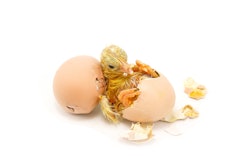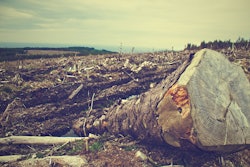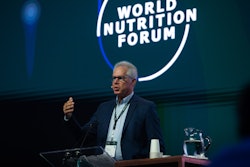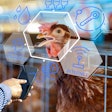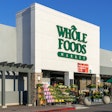
Guest column: Lara Moody, executive director, Institute for Feed Education and Research (IFEEDER)
During the June 2023 Field to Market: The Alliance for Sustainable Agriculture Plenary & General Assembly Meeting, I moderated a panel exploring the path to sustainable feed, where I was joined by three industry stakeholders representing different areas of the value chain.
As the agrifood sector seeks opportunities to use feed to reduce the environmental footprint of animal production, the discussion focused on the importance of innovation in its many forms — linking solutions from feedstuff production to the rations consumed by the animals.
Here are the highlights and the insights I gleaned from the conversation.
Paying for innovation
Implementing innovation needs to be considered and supported by the whole animal value chain, but weighing the costs versus the benefits of the investment — and being able to prove its value — is an important part of the equation.
“The projects we undertake need to put money directly back into our farmer-owner pockets," said Samantha Bild, national sales director for animal nutrition at CHS Inc., noting that the farmer-owned cooperative is “farmer-facing first.”
"With this approach, farmers are open and adaptable to innovation," she said. "In animal production, there is only so much margin a producer can make, and we probably don’t talk about that enough. When we’re asked if we can add an additive to reduce emissions, we have to consider that the additive is part of a ration. Because feed is the biggest cost to a producer, as an ingredient supplier, we must create extra room within those costs for that additional ingredient. We need help from everyone in the supply chain to create increased margins for the practices the value chain wants to see implemented in the production system.”
The cost of innovation also extends to raw material production.
“The margin challenge exists in the crop field too," said Sally Flis, director of sustainability program design and outcome management at Nutrien Ag Solutions. "It’s not about the dollars per acre we’re going to pay the grower today for applying a practice change. For each grower, we have to figure out what the limiting factor is for them to make a decision to move forward. It could be to labor, time, equipment or logistics.”
An additional price incentive or ecosystem service payments may help implement innovation.
“There is a difference between price and cost," Bild said. "We may be looking at incentivizing the price today, but ultimately, it’s the cost to the producer and support for the resiliency of the farm long term that matters. The incentive value to try something today may cost them much more down the road because of the uncertainties around it.”
Highlighting the need for better margins, Heather Tucker, manager of global ruminant technology at Novus International, explained that feed accounts for 60% to 70% of a producer’s bill.
“That’s a huge bill just to feed your animal to make money," she said. "Layer on top of that the need to meet a downstream stakeholder’s desire, like methane reduction, and the economics can be challenging. If we come up with a $2 per head solution for a producer, we need to be able to also show if it’s cost effective. Ultimately, we need to ensure there is a way to reduce and recover the cost for the producer so when it’s not incentivized can we still provide a pathway to change.”
According to Tucker, Novus regularly innovates solutions to add other tangible benefits to a customer’s desired needs.
For example, its bis-chelated trace minerals increase the reproduction rates in the dairy herd, but the company has also invested in the research to show farmers how they can use their products to reduce their trace mineral inclusion rates to achieve the same performance for less money. This research is also shared with their partners to explore collaboration opportunities or identify future gaps that need to be addressed.
Supporting innovation
Innovation is driven and informed by need, and the feed industry benefits by understanding what’s happening across the value chain.
Tucker believes companies need to be thinking five years ahead, e.g. poultry genetics constantly change, meaning Novus is constantly re-evaluating its recommendations.
Sometimes older solutions fall out of favor and companies must develop new ones; balancing changes in the sector with customer demand can be tricky.
"For example, we saw consumer demands result in increased antibiotic-free production. Producers turned to supplementing minerals, such as copper, at higher levels to serve a solution for the challenges some antibiotics resolved. However, regulations around mineral excretion are now exerting pressures on the use of higher mineral supplementation," Tucker said.
“To innovate, it’s really important for us to have a good dialogue with folks in the field," she said. "We hold a lot of discussions with downstream and upstream folks in our system to understand what they need in the next five years. Sometimes it’s not a product, but a service.”
The company does a lot of feed ingredient analysis, which has allowed it to identify the differences soybean processing can have on its nutritional elements. While it may not yet have a solution for the concern, the company can provide the producer with information and other considerations as they work together to achieve the animal’s full potential.
“We’re in this journey to get meaningful contact with customers," Tucker said. "Our pain points are customers’ pain points, so we need to be in conversation and dialogue to understand the full perspective.”
Innovation to support sustainability goals
Each panelist provided examples of innovations their companies have adopted to improve the environmental impact of agriculture.
• Data collection
Innovation for crop production starts in the field.
“It’s important to look at what practices we can implement to grow a lower footprint feed, and at the same time make a feed that is more efficient within the ration," said Flis of Nutrien Ag Solutions. "We need to optimize the acre not only for yield, but also quality of the product."
For example, the company applies product to "free up" phosphorus (P) bound to the soil, unlocking it without having to apply additional P as manure or fertilizer, or it can use products that stabilize or extend the availability of applied nitrogen (N) for the crop to prevent loss and reduce application volume.
Tracking efforts to optimize the acre is also important.
Nutrien is a Field to Market-qualified data management partner. The company's Agrible tool is integrated with Field to Market's Fieldprint Platform, an assessment framework embedded into third-party tools and software that allows food system stakeholders to measure the environmental impacts of commodity crop production and identify opportunities for continuous improvement. When Agrible’s inputs match the inputs in the platform, it serves as a pathway to collect baseline information for Nutrien’s N management program.
"Each year, the data is thoroughly checked to ensure it's an accurate representation of a grower’s farm, which gives us confidence in the information being submitted into a carbon program or sharing with a project collaborator," Flis said.
• Transportation
Innovation also occurs relative to how the ration components are produced, handled and developed.
Novus International's Tucker defines “sustainability” in this context as striving to provide environmentally focused solutions that are financially feasible for producers.
“We have to achieve a balance between environmental protections and ensuring that our customers and their customers can deliver in a way that we can continue to have animal agriculture in this world that is meaningful and sustainable,” she said.
Within that, the company is also focused on making and delivering its products in a sustainable manner.
“Whether it’s our logistics team looking at shipping lanes and trucking operations — we’ve been able to reduce miles traveled by our products by 28% in recent years — or moving away from large disposable totes to intermediate bulk containers (IBCs) we put onto tankers to reduce our waste, we look at innovation holistically,” Tucker said.
• Novel solutions
Innovation in the feed industry should support animal-producing customers.
“Something as simple as a tub can have economic and social benefits," Bild said. "There is an economic impact because of what you are supplying in the tub, for example, a protein or energy supplement for consumption while animals are grazing. But we’re also looking at how we could use biodegradable tubs. With no plastic or metal tub to dispose of, biodegradable tubs would mean less waste for the environment, but we’d also be supporting the rancher because they wouldn’t need to have extra labor to go pick up those tubs and recycle or dispose of them. We must explore the multiple ways benefits may occur throughout the value chain, not just from the environmental side but also relative to economic, welfare and well-being.”
Bild said CHS relies on feed ingredient partners to help them with innovation, but says considerations must be made when determining what innovations to take part in, by quantifying and evaluating the innovation from a producer’s standpoint.
Traceability is key to producers, but implementing successful systems requires new innovations.
“Traceability is important because [CHS] wants the producer to be compensated for all the activities implemented to reduce their footprint or meet a consumer desire for the animal," Bild said, highlighting that the use of radio frequency identification (RFID) ear tags helps the cooperative track and document the producer's efforts so they can get a premium.
"Introducing and helping support traceability of the animal itself is something we are working on across all animal life stages," she added. "Ensuring the right tags or tracking stays with the animal through its life cycle to document all the feed for that animal is a necessity to ultimately be able to pay for an additive you feed for an environmental benefit but with a greater cost.”
Keep feed, producers in mind
Field to Market events provide agricultural stakeholders from all parts of the value chain a great opportunity to engage with the feed industry.
CHS's Bild challenges the food value chain to engage feed and animal protein producers in the sustainability discussion, noting that she has rarely been to a sustainable agriculture, technology or regenerative agriculture conference where protein is a core discussion.
“Rarely do I go in the field when a producer doesn’t ask me what they need to invest in now that will add value in the future. What are we not doing today and what should they be doing next,” she said, stressing they can’t make an investment because of a trend; they need to invest in something that will add value over time.
“There is a big difference between food and feed," Bild said. "A lot of the conversations here are about food, but we need it to be about feed too.”
Editor's note:
Field to Market: The Alliance for Sustainable Agriculture is a multi-stakeholder initiative working to unite the U.S. agricultural supply chain to focus on sustainable production.
Lara Moody is the executive director for the Institute for Feed Education and Research (IFEEDER), which seeks to advance understanding and trust in a sustainable feed and pet food supply chain through timely research and education. IFEEDER is currently collaborating with industry members and stakeholders on a multifaceted strategy to advance feed systems sustainability. Learn more at ifeeder.org/sustainability.



